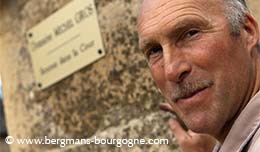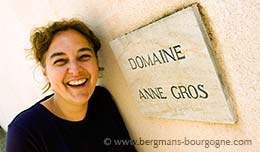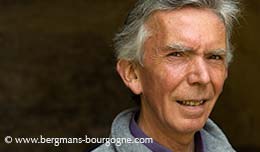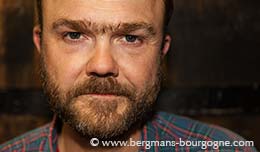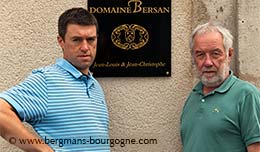
he majority of the Domaine Martin-Dufour vineyards are within sight of the Corton hill. The appellations differ, but the distances are short. Chorey-lès-Beaune, Savigny-lès-Beaune, Ladoix-Serrigny and Aloxe-Corton, none of them further away than a kilometre or two. In other words, a perfect lesson in Burgundy terroir and its nuances.
– The Ladoix soil is halfway between the brown soil of Chorey-lès-Beaune and the redder soil of Aloxe-Corton. The soil is stonier, drier and not very deep, says Jean-Paul Martin at Domaine Martin-Dufour.
Jean-Paul Martin is in his cellar on Rue des Moutots in Chorey-lès-Beaune. Together with his wife Pascale he has been running this 9.6 hectare domaine since 1990. The red Ladoix of Domaine Martin-Dufour comes from vines in Les Chaillots, a plot in Ladoix just downslope from the Corton grand crus and the Aloxe-Corton premier crus.
 – The bedrock is close to the surface and it is not always easy to work the soil. It is quite steep, so when it rains we have a lot of water coming down the Corton hill, taking the soil with it.
– The bedrock is close to the surface and it is not always easy to work the soil. It is quite steep, so when it rains we have a lot of water coming down the Corton hill, taking the soil with it.
Domaine Martin-Dufour goes back, at least, six generations in Chorey-lès-Beaune. But it was not until relatively recently that the domaine began to expand. Up until Jean-Paul Martin’s father’s generation the focus was on regional appellations. Daniel Martin arrived at the domaine in 1959 and bought a parcel in the Savigny-lès-Beaune premier cru Les Hauts Marconnets, but apart from that there was mainly Bourgogne Aligoté and Bourgogne Pinot Noir, with a bit of Chorey-lès-Beaune and Savigny-lès-Beaune thrown in.
 – When I arrived we added the white Chorey-lès-Beaune, Aloxe-Corton, Ladoix and Nuits-Saint-Georges, says Jean-Paul Martin. The Nuits-Saint-Georges vines were already in the family, but since it was in the Côte de Nuits, 15 kilometres from Chorey-lès-Beaune, they had never been farmed by the family. They came from my grandfather on the Dufour side of the family, my mother’s side. At the time it was obviously too far away, but for me it was a great addition to the domaine.
– When I arrived we added the white Chorey-lès-Beaune, Aloxe-Corton, Ladoix and Nuits-Saint-Georges, says Jean-Paul Martin. The Nuits-Saint-Georges vines were already in the family, but since it was in the Côte de Nuits, 15 kilometres from Chorey-lès-Beaune, they had never been farmed by the family. They came from my grandfather on the Dufour side of the family, my mother’s side. At the time it was obviously too far away, but for me it was a great addition to the domaine.
There are two Nuits-Saint-Georges bottlings at the domaine, one village Nuits-Saint-Georges and one premier cru.
– For the village Nuits-Saint-Georges we have our vines in a lieu-dit called Au Chouillet. It is roughly halfway between Nuits-Saint-Georges and Vosne-Romanée. There is a clear difference between the Nuits-Saint-Georges wines from the Vosne-Romanée side and the ones from the Prémeaux-Prissey side. On the Prémeaux-Prissey side you have harder tannins, relatively tough wines. On the Vosne-Romanée side you have wines with more finesse.
 – Au Chouillet is almost flat. The soil is quite deep, rich. But it is well-drained. When it has been raining the water does not stay.
– Au Chouillet is almost flat. The soil is quite deep, rich. But it is well-drained. When it has been raining the water does not stay.
The Nuits-Saint-Georges premier cru is Aux Argillats. It is on the same side of Nuits-Saint-Georges as Au Chouillet, but up on the slope.
– It is the first premier cru next to the village as you leave towards the Hautes-Côtes, says Jean-Paul Martin. The soil is not as deep and the wine is relatively subtle. It is not as full-bodied as other premier crus.
 Back in Chorey-lès-Beaune there is village wine in both colours. The red Chorey-lès-Beaune comes from Les Beaumonts, a lieu-dit often regarded as one of the top plots of the village.
Back in Chorey-lès-Beaune there is village wine in both colours. The red Chorey-lès-Beaune comes from Les Beaumonts, a lieu-dit often regarded as one of the top plots of the village.
– We have several parcels for the red Chorey-lès-Beaune, but they are all within the same lieu-dit, Les Beaumonts, says Jean-Paul Martin. We have a large chunk of Chorey-lès-Beaun there, three hectares spread out over five parcels. In reality there are ten parcels, because the vines were planted in different years.
– The soil is pretty much the same all across Les Beaumonts. It is relatively deep and well-drained. But it is primarily for red wines. While most of Chorey-lès-Beaune is east of the Beaune-Dijon road Les Beaumonts is west of the road, touching on both Aloxe-Corton and Savigny-lès-Beaune.
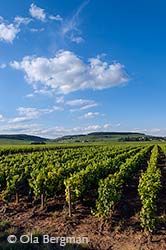 The white Chorey-lès-Beaune comes from the other side of the road, close to the roundabout just outside Beaune.
The white Chorey-lès-Beaune comes from the other side of the road, close to the roundabout just outside Beaune.
– We have a parcel in Poirier. That is right next to the car dealer in Chorey-lès-Beaune. It is planted with both chardonnay and pinot noir. The chardonnay was planted in 2005. Poirier is relatively stony. It is well-drained. The soil type is quite similar to Les Clous, which just south of Poirier. Inside Poirier the soil is quite varied. I would say the lieu-dit is too large, because if you compare the northern and the southern end the difference in soil type is too large.
– Poirier and Les Petits Champs Longs are among the best in Chorey-lès-Beaune for chardonnay. Les Beaumonts with its rich soil is excellent for reds, but it would produce whites that are too heavy.
The red village Savigny-lès-Beaune comes from three different lieux-dits – Les Pimentiers (0.3 ha), Les Champs Chardons (0.3 ha) and Les Picotins (0.7 ha). Part of Les Picotins was recently uprooted and will be planted with chardonnay.
 – These are three slightly different soil types, says Jean-Paul Martin. In Les Champs Chardons the soil is deeper, quite humid. In Les Picotins and Les Pimentiers it is drier. Together they produce a balanced cuvée.
– These are three slightly different soil types, says Jean-Paul Martin. In Les Champs Chardons the soil is deeper, quite humid. In Les Picotins and Les Pimentiers it is drier. Together they produce a balanced cuvée.
The Savigny-lès-Beaune premier cru, Hauts Marconnets, is as far south you can get in Savigny-lès-Beaune. It is right next to the motorway to Paris and Domaine Martin-Dufour share it with Beaune négociant Chanson and the Hospice de Beaune.
– Hauts Marconnets is quite dry and stony, explains Jean-Paul Martin. The bedrock is close. It is always early-ripening, good maturity. It is often the first parcel we harvest.
The smallest cuvée of the domaine is their Aloxe-Corton. The 0.10 hectares in Les Boutières only produce about 600 bottles annually.
– Aloxe-Corton Les Boutières is right next to Chorey-lès-Beaune Les Beaumonts, says Jean-Paul Martin. The soil is not all the same though. It is very red, almost black. The stones are white in Chorey-lès-Beaune, but here they are ochre coloured.
– Despite being so close to each other you have two very different characters here, Aloxe-Corton and Chorey-lès-Beaune. People who go for the Aloxe-Corton are looking for wines to keep. Chorey-lès-Beaune is a small appellation, not very well-known, with a good price/quality ratio. The Savigny-lès-Beaune wines are more well-known, typical Côte de Beaune wines. Chorey-lès-Beaune has a bit more personality. Some like it, some don’t.
© 2013 Ola Bergman










